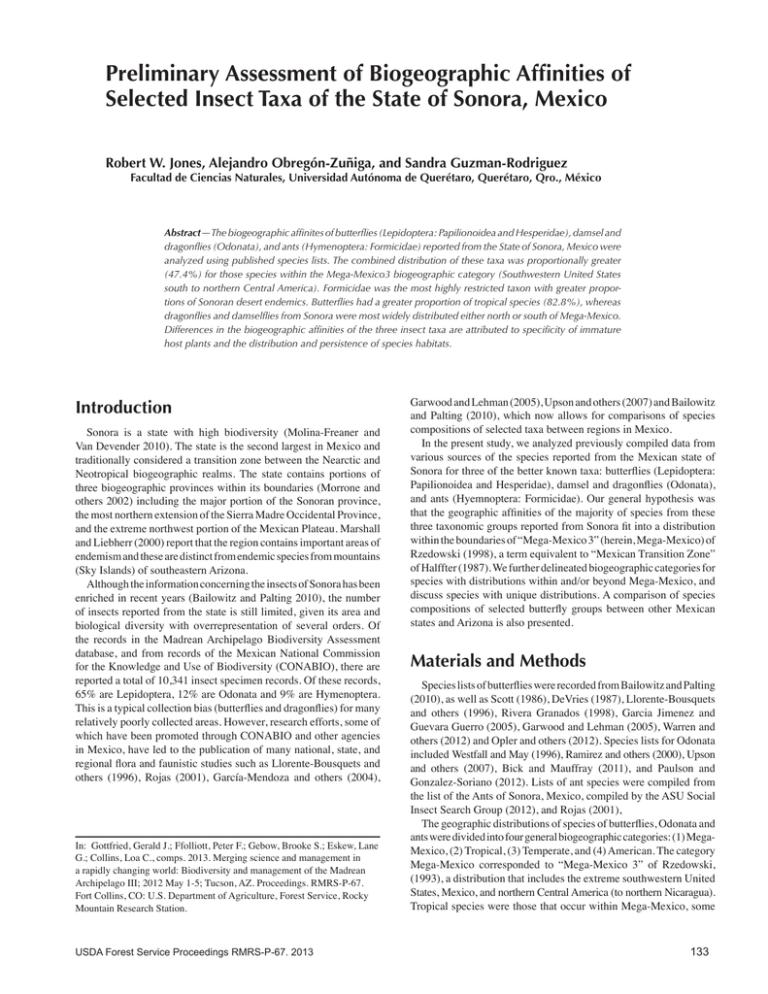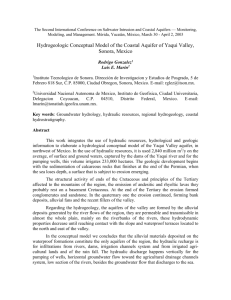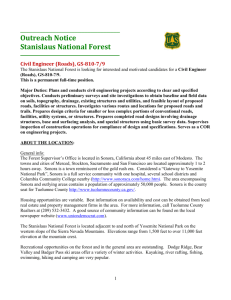Preliminary Assessment of Biogeographic Affinities of
advertisement

Preliminary Assessment of Biogeographic Affinities of Selected Insect Taxa of the State of Sonora, Mexico Robert W. Jones, Alejandro Obregón-Zuñiga, and Sandra Guzman-Rodriguez Facultad de Ciencias Naturales, Universidad Autónoma de Querétaro, Querétaro, Qro., México Abstract—The biogeographic affinites of butterflies (Lepidoptera: Papilionoidea and Hesperidae), damsel and dragonflies (Odonata), and ants (Hymenoptera: Formicidae) reported from the State of Sonora, Mexico were analyzed using published species lists. The combined distribution of these taxa was proportionally greater (47.4%) for those species within the Mega-Mexico3 biogeographic category (Southwestern United States south to northern Central America). Formicidae was the most highly restricted taxon with greater proportions of Sonoran desert endemics. Butterflies had a greater proportion of tropical species (82.8%), whereas dragonflies and damselflies from Sonora were most widely distributed either north or south of Mega-Mexico. Differences in the biogeographic affinities of the three insect taxa are attributed to specificity of immature host plants and the distribution and persistence of species habitats. Introduction Sonora is a state with high biodiversity (Molina-Freaner and Van Devender 2010). The state is the second largest in Mexico and traditionally considered a transition zone between the Nearctic and Neotropical biogeographic realms. The state contains portions of three biogeographic provinces within its boundaries (Morrone and others 2002) including the major portion of the Sonoran province, the most northern extension of the Sierra Madre Occidental Province, and the extreme northwest portion of the Mexican Plateau. Marshall and Liebherr (2000) report that the region contains important areas of endemism and these are distinct from endemic species from mountains (Sky Islands) of southeastern Arizona. Although the information concerning the insects of Sonora has been enriched in recent years (Bailowitz and Palting 2010), the number of insects reported from the state is still limited, given its area and biological diversity with overrepresentation of several orders. Of the records in the Madrean Archipelago Biodiversity Assessment database, and from records of the Mexican National Commission for the Knowledge and Use of Biodiversity (CONABIO), there are reported a total of 10,341 insect specimen records. Of these records, 65% are Lepidoptera, 12% are Odonata and 9% are Hymenoptera. This is a typical collection bias (butterflies and dragonflies) for many relatively poorly collected areas. However, research efforts, some of which have been promoted through CONABIO and other agencies in Mexico, have led to the publication of many national, state, and regional flora and faunistic studies such as Llorente-Bousquets and others (1996), Rojas (2001), García-Mendoza and others (2004), In: Gottfried, Gerald J.; Ffolliott, Peter F.; Gebow, Brooke S.; Eskew, Lane G.; Collins, Loa C., comps. 2013. Merging science and management in a rapidly changing world: Biodiversity and management of the Madrean Archipelago III; 2012 May 1-5; Tucson, AZ. Proceedings. RMRS-P-67. Fort Collins, CO: U.S. Department of Agriculture, Forest Service, Rocky Mountain Research Station. USDA Forest Service Proceedings RMRS-P-67. 2013 Garwood and Lehman (2005), Upson and others (2007) and Bailowitz and Palting (2010), which now allows for comparisons of species compositions of selected taxa between regions in Mexico. In the present study, we analyzed previously compiled data from various sources of the species reported from the Mexican state of Sonora for three of the better known taxa: butterflies (Lepidoptera: Papilionoidea and Hesperidae), damsel and dragonflies (Odonata), and ants (Hyemnoptera: Formicidae). Our general hypothesis was that the geographic affinities of the majority of species from these three taxonomic groups reported from Sonora fit into a distribution within the boundaries of “Mega-Mexico 3” (herein, Mega-Mexico) of Rzedowski (1998), a term equivalent to “Mexican Transition Zone” of Halffter (1987). We further delineated biogeographic categories for species with distributions within and/or beyond Mega-Mexico, and discuss species with unique distributions. A comparison of species compositions of selected butterfly groups between other Mexican states and Arizona is also presented. Materials and Methods Species lists of butterflies were recorded from Bailowitz and Palting (2010), as well as Scott (1986), DeVries (1987), Llorente-Bousquets and others (1996), Rivera Granados (1998), Garcia Jimenez and Guevara Guerro (2005), Garwood and Lehman (2005), Warren and others (2012) and Opler and others (2012). Species lists for Odonata included Westfall and May (1996), Ramirez and others (2000), Upson and others (2007), Bick and Mauffray (2011), and Paulson and Gonzalez-Soriano (2012). Lists of ant species were compiled from the list of the Ants of Sonora, Mexico, compiled by the ASU Social Insect Search Group (2012), and Rojas (2001), The geographic distributions of species of butterflies, Odonata and ants were divided into four general biogeographic categories: (1) MegaMexico, (2) Tropical, (3) Temperate, and (4) American. The category Mega-Mexico corresponded to “Mega-Mexico 3” of Rzedowski, (1993), a distribution that includes the extreme southwestern United States, Mexico, and northern Central America (to northern Nicaragua). Tropical species were those that occur within Mega-Mexico, some 133 Jones, Obregón-Zuñiga and Guzman-Rodriguez of which extended as far north as the southwestern United States, but are recorded south beyond northern Central America into southern Central America and/or into South America. The species categorized as temperate species had distributions extending north of the southwestern United States (north of the limits of Mega-Mexico 3), with distributions extending south into Mexico and, rarely, into northern Central America. American species were those with ranges from the central to the northern United States, and/or Canada, into south Central America and/or South America and/or the Caribbean. Within each of the four categories, further categories were grouped based on previously reported discontinuities reported by Halffter (1987): the Transverse Volcanic Belt, and the Isthmus of Tehuantepec. Thus, species from Mega-Mexico were further subdivided into (1) species found throughout Mexico, and also south of the Isthmus of Tehuantepec; (2) species with ranges in north and central Mexico but found only north of the Isthmus of Tehuantepec; (3) Northern species found north of the Trans volcanic axis; and (4) Sonoran endemics. Temperate subcategories were based the separation of eastern and western north America, an important pattern noted by Noonan (1988) and included (1) species from Sonora that extended to the western Rocky Mountain States north of Mega-Mexico, sometimes into Canada, but not into the central or eastern United States; (2) species reported from Sonora but did not extend into the Rocky Mountains and found in the southeast and/or central eastern United States; and (3) species from Sonora found in both the eastern and western United States, sometimes also into Canada. Subcategories of tropical species from Sonora were (1) species whose range extended south into southern Central America (south of Nicaragua); (2) those reported into southern Central America and the Caribbean; and (3) species extending into South America and the Caribbean. Comparison of proportions between biogeographic categories among taxa were made using a χ2 pairwise analysis and species composition between regions with a cluster analysis using Jaccard’s index. The cluster analysis was conducted using representative regions (states) within Mexico (Veracruz, Tamaulipas, Chiapas, Querétaro, and Sonora) and the State of Arizona. The butterfly families Pieridae and Papilionidae were used as these taxa had the most complete and comparable data. Both analyses were performed with the PAST® statistical software program (Hammer and others 2001). Results The combined distribution of butterflies, dragonflies, damselflies and ants were proportionally greater for those species within the MegaMexico 3 biogeographic category (47.4%), followed by species with Tropical distributions (28.2%), Temperate (13.5%), and American (10.8%). Of the species within Mega-Mexico, the greatest proportion of species (27.3%) had distributions southward from Sonora, but not extending beyond the Isthmus of Tehuantepec with 13.9 % found from Sonora into south Mexico or beyond into northern Central America. All other subcategories (species extending beyond MegaMexico to the north, south, or both) had 11% or less of the species totals. Species endemic to the Sonoran desert accounted for 6.3%, of which 76.9% were species of ants. The proportions of species within these four general biogeographic categories were not similar between the three taxa compared ( fig. 1) and all pairwise comparisons were significantly different (χ2 > 40, df = 3, p < 0.01). Formicidae was the most highly restricted taxon with 82 species (78.1%) found only within Mega-Mexico, and of these, 30 species 28.6% were classified as Sonoran desert endemics. Of the species from Mega-Mexico, 50 species (47.7%) were found from the Sonoran desert and into parts of central Mexico and only two species 134 Preliminary Assessment of Biogeographic Affinities of Selected Insect Taxa . . . Figure 1—Biogeographic affinities of species of butterflies (Lepidoptera), dragonflies and damselflies (Odonata) and ants (Hymenoptera: Formicidae) reported from the State of Sonora, Mexico. A. Species endemic to the Sonoran Desert region (United States and Mexico); B. Species of reported within the southwestern United States and/or north and central Mexico but found only north of the isthmus of Tehuantepec; C. Species of reported within the limits of Mega-Mexico including regions north isthmus of Tehuantepec, and also from southern Mexico and/or northern Central America; D. Species restricted to Mega-Mexico to the south and also found in the western United States; E. Species restricted to Mega-Mexico to the south and also found in the eastern and western United States; F. Species restricted to Mega-Mexico to the north and also found in the southern Central America; G. Species restricted to MegaMexico to the north with ranges extending into South America, and/or the Caribbean; H. Species with ranges extending both north and south of the limits of Mega-Mexico. (1.9%) extended beyond the Isthmus of Tehuantepec. Only 12 ant species (11.4% ) found in Sonora had distributions extending northwards beyond the southwestern states ( fig. 1), nine (8.6%) extended into Central America and beyond, and only two were found in both temperate and tropical latitudes. Butterflies also had notable proportions of species from MegaMexico ( fig. 1), but had a greater proportion than the other taxa of tropical, wide ranging species (82.8 % either from Mega-Mexico or further south). These extended primarily from the northern limits of Mega-Mexico into southern Central America (32 species; 10.4%) or beyond into South America and/or the Antilles (85 species; 27.6%). Sonoran butterflies that had both temperate and tropical latitudes accounted for less than 5 percent of the species. USDA Forest Service Proceedings RMRS-P-67. 2013 Preliminary Assessment of Biogeographic Affinities of Selected Insect Taxa . . . Jones, Obregón-Zuñiga and Guzman-Rodriguez Species of dragonflies and damselflies from Sonora were the most widely distributed of the three taxa. Almost half (47.9%) of the species found in Sonora were also reported from southern Central America, the Antilles, and/or the South America, or had even greater distribution range from the eastern or western United States south beyond the southern limits of Mega-Mexico. The Odonata also had the greatest number of species from Sonora that were also found in the central and/or eastern United States (84; 35.7%). Comparisons of species compositions of Pieridae and Papilionidae butterflies reported from Sonora with other regions indicated an expected differentiation between southern and northern Mexican regions with important differences between the adjacent States of Sonora and Arizona ( fig. 2). For Papilionidae, there was greater similarity between Sonora and the northeastern State of Tamaulipas, over 1000 km to the east, than to adjacent Arizona. The species composition of Pieridae indicated that Sonora was the most different from all regions with less than 40% shared species with Arizona and Tamaulipas, with the southern states forming a cluster similar to that found with Papilionidae. The central State of Querétaro did not align with the northern regions, but with Veracruz and Chiapas; this despite its connection with Tamaulipas through the Sierra Madre Oriental and having regions of Chihuahuan desert “relicts” (Morafka 1978), which share arid adapted plant species with northeastern Sonora (Morrone and others 2002). Figure 2—Cluster analysis of species richness of Papilionidae and Pieridae (Lepidoptera) from various states of Mexico using Jaccard’s Index. USDA Forest Service Proceedings RMRS-P-67. 2013 Discussion Biogeographic distributions are the product of ecological constraints and past geological events (Endler 1982; Casazza and others 2008; Kalkman and others 2008). However, separating these factors and specific methods, such as phylogenetic reconstructions, is difficult (Endler 1982), and not within the scope of the present study. However, a comparative approach may give preliminary insights into explaining the differences and similarities between the distributions of the three taxa reported within the political boundaries of Sonora. The key ecological factors determining most insect distributions are those related to trophic relationships and microhabitat. In the case of butterflies, trophic associations and distributions are clearly linked because butterflies are where their host plants are, at least during larval stages. In the present data set used, all of the 15 most widespread species (American distribution) are polyphagous and reported from a wide range of plant species. For example, Achlyodes tamenund, is found on the many species of the Rutaceae family including Citrus spp., Erynnis funeralis is found on 13 genera of Leguminosae, and Panoquina ocola feeds on several genera of Poaceae, including rice and sugarcane. The only exception to the polyphagous habit of widespread species is Copaeodes minima, which is restricted to feeding as larvae on Cynodon dactylon, the widely cultivated Bermuda grass. Of the two Sonoran endemic species recorded here, their distribution, as well, is determined by the range of their larval host plant. Both are species of Hesperiidae and are specific to species of Agavaceae of the Sonoran desert: Agathymus aryxna on Agave palmeri and A. chrysantha on Agave schotti (Scott1986). Although the presence of adequate hosts plants is clearly not the only determinate of butterfly distributions (Dingle and others 2000), especially for the highly mobile adult stage, the effect of historical factors and ecological limitations on their host plants is the primary predictor of butterfly distribution. Comparison of species composition of Papilionidae and Pieridae (fig. 2) among selected states of Mexico and Arizona had an expected separation between southern Mexican States of Oaxaca, Chiapas, and Veracruz with the northern states of Tamaulipas, Sonora and Arizona. The central State of Queretaro, although compiled from collections in the arid regions of the state, has more affinities to the south than north. The greater similarity of Papilionidae between Tamaulipas and Sonora, than Sonora with adjacent Arizona, was notable and probably reflects the increasing dominance of tropical plants as one goes further south in Sonora, as is found in southern Tamaulipas. The relative dissimilarity between the butterfly fauna of Sonora and Arizona ( fig. 2) is also reported by Marshall and Liebherr (2000) between temperate and tropical adapted species of other faunal groups and plants. In the case of butterflies, this dissimilarity is probably because many tropical butterflies and their host plants (Felger and others 2001) reach their most northern distribution in the State of Sonora, particularly in the Sierra Madre Occidental, and these butterflies rarely reach the United States' border. The distribution of species of Odonata are determined by the distribution of suitable aquatic habitats (Kalkman and others 2008), although like butterflies, they can be found far from immature habitats. Kalkman and others (2008) report that the Southwestern United States is a center of diversity and endemism of dragonflies but many species are wide-ranging, a pattern also found for species from northwestern 135 Jones, Obregón-Zuñiga and Guzman-Rodriguez Mexico. Because of the highly developed flight capabilities of adults and the fact that both adults and nymphs are predaceous and feed on a wide variety of prey, it is easy to understand how many species can maintain widespread distributions. However, species with highly restricted distributions are more difficult to explain, partially because there is much to learn about microhabitat requirements of Odonata, and accurate population estimates are usually lacking (Abbott 2005). Also, lacking is an understanding of specific adaptations of Odonata to unpredictable, marked seasonality of aquatic habitats in tropical regions such as Sonora. Ant species had the most restricted distributions of the taxa examined, with greater numbers of species restricted to the Sonoran Desert. The Sonora Desert has a unique climatic regime (Ives 1949; Ehleringer 1985), which apparently has persisted as a desert refuge throughout the Quartenary (Hewitt 2000). As foraging success and colony function of ants are tightly limited by temperature and humidity (Hölldobler and Wilson. 1990), the climatic conditions and persistence of the Sonoran desert ecosystem through time have apparently been conducive to the speciation and survival of ant species. Close to half of the ant species of Sonora had distributions throughout northern Mexico, particularly in states within the Chihuahuan desert, including Arizona and New Mexico, suggesting distributional limitations due to specialization in arid environments. Further collection of the insect groups discussed here, as well as other taxa within the State of Sonora, will certainly improve our understanding of the complex and intriguing topic of the biogeographic affinities of Sonoran insects. Increased international cooperation between scientists in Mexico and the United States is necessary to coordinate future collection efforts and share systematic knowledge of the insects of Sonora, Mexico, and, specifically, their Sky Islands. Many specimens collected from Sonora are already present in collections that also need to be incorporated into present data bases. These efforts also need to be coordinated for all the surrounding states of Sinaloa, Chihuahua, and Baja California, which will lead to a more unified understanding of the natural history of the Northwestern Mexican-Southwestern United States region. Acknowledgments We wish to thank Tom Van Devender and John Abbott for help in acquiring references and comments and to Mahinda Martínez y Díaz de Salas and Carlos López González for reviews of the manuscript. References Abbott, J.C. 2005. Dragonflies and damselflies of Texas and the south-central United States. Princeton University Press. 344 pp. Alatore C. and M. Vasquez. 2010. Lista comentada de hormigas (Hymenoptera:Formicidae) del norte de Mexico. Dugesiana 17: 9-36. ASU Social Insect Search Group. 2012. Preliminary list of ants (Hymenoptera: Formicidae) of Sonora Mexico, [Online] Available: http://www.asu.edu/clas/ sirgtools/Ants%20of%20Sonora, %20 Mexico,%20list.pdf , [May 20, 2012] Bailowitz , R.A. and J. Palting. 2010. Biodiversidad de los insectos con especial énfasis In Lepidoptera y Odonata. In: F.E. Molina-Freaner and T.R. Van Devender, (eds.). Diversidad Biológica de Sonora. UNAM, Mexico, pp. 315-337 Barrientos, A., J.V. Correas, and J. Garcia, eds. 2005. Biodiversidad Tamaulipeca Vol1. Direccion General de Educacion superior Tecnologica- Instituto Tecnologico de Cd. Victoria, Tamaulipas,. Mexico. pp 146-149. Bick, G.H. and W. Mauffray. 2012. Distributin summary of North American Anisoptera. [Online] Available: http://bellsouthpwp.net/b/i/billmauffray/ nalist.html [May 20, 2012]. 136 Preliminary Assessment of Biogeographic Affinities of Selected Insect Taxa . . . Casazza, G.E. Zappa, M.G. Mariotti, F. Medail, and L. Minuto. 2008. Ecological and historical factors affecting distribution pattern and richness of endemic plant species: The case of the Maritime and Ligurian Alps hotspot. Diversity and Distributions 14: 47-58. DeVries, P.J. 1987. The butterflies of Costa Rica and their natural history: Papilionidae, Pieridae, Nymphalidae. Princenton University Press, U.S.A. Dingle, H., M.P. Zalucki, and W.R. Rochester. 2000. Relationships among climate, latitude, and migration: Australian butterflies are not Temperate Zone birds. Oecologia 124:196-207. Ehleringer, J.R. 1985. Annuals and perennials of warm deserts. p. 162-180. In: Chabot, B.F. and H.A. Mooney, eds. Physiological Ecology of North American Plant Communities. Chapman and Hall, New York. Endler, J.A. 1982. Problems in distinguishing historical from ecological factors in biogeography. Integrative and Comparative Biology 22: 441-452. Felger, R.S., M.B. Johnson, and M.F. Wilson. 2001. The trees of Sonora, Mexico. Oxford University Press, Oxford. pp. 3-28. Garcia Jimenez, J. and Gonzalo Guevara Guerro. 2005. Mariposas. In: Barrientos, L.L., A. Correa S., J.V. Horta, and J. García J., eds. Biodiversidad Tamaulipeca. Vol. 1. D.G.E.S.T- Instituto Tecnológico de Cd. Victoria, Tamaulipas, México. pp. 125-137. García-Mendoza A. J., M. de J. Ordóñez Díaz, M. Briones-Salas, Abisaí, J. García-Mendoza. 2004. Mariposas del Estado de Tamauliapas, Redacta S. A. de C. V., Mexico, D. F. 603 pp. Garwood, K. and R. Lehman. 2005. Butterflies of Northeastern Mexico. Nuevo Leon, San Luis Potosi, Tamaulipas. A Photographic Checklist . 2nd Edition. Eye Scry Publishing, McAllen, Texas. 194 pp. Halffter, G. 1987. Biogeography of the montane entomofauna of Mexico and Central America. Annual Review of Entomology 32: 95-114. Hammer, O., Harper, D.A.T., and P.D. Ryan, 2001. PAST: Paleontological Statistics Software Package for Education and Data Analysis. Palaeontologia Electronica 4(1): 9 pp. Hewitt, G. 2000. The genetic legacy of the Quartenary ice ages. Nature 405: 907-913. Hölldobler, B. and E.O. Wilson. 1990. The Ants. Belkap Press of Harvard, Harvard University Press, Cambridge, MA. Ives, R. 1949. Climate of the Sonoran desert region. Annals of the Association of American Geographers. 39(3): 143-187. Llorente, J.E., A. Luis Martínez, I. Vargas Fernández, and J. Soberón Mainero. 1996. Papilionoidea (Lepidoptera). In: J. Llorente Bousquets, A.N. García Adrete and E. González Soriano, eds. Biodiversidad, taxonomía y biogeografía de artrópodos de México: Hacia una síntesis de su conocimiento. Instituto de Biología, UNAM, México, D. F. Llorente, J.E., L.O. Oñate, A.M. Luis, and I.F. Vargas. 1997. Papilionidae y Pieridae de México: Distribución Geográfica e Ilustración. Comisión Nacional Para el Conocimiento y Uso de la Biodiversidad (CONABIO) y Facultad de Ciencias, Universidad Nacional Autónoma de México, México, D.F. viii + 227pp. Marshall, C.J. and J.K. Lieberr. 2000. Cladistic biogeography of the Mexican transition zone. Journal of Biogeography 27: 203-216. Molina-Freaner, F.E. and TR. Van Devender. 2010. Diversidad biológica de Sonora. In: F.E. Molina-Freaner, and T.R. Van Devender, eds. Diversidad Biológica de Sonora. UNAM, Mexico, pp. 315-337. Morafka, D.J. 1978. Is there a Chihuahuan Desert? A quantitative evaluation through the herpetofaunal perspective. In: Transactions of the Symposium of the Biological Resources of the Chihuahuan Desert Region, United States and Mexico, U.S. National Park Service Transactions and Proceedings Series, 437-454. Washington, DC: Government Printing Office. Morrone, J.J. 2002. Mexican biogeographic provinces: preliminary scheme, general characterizations and synonymies. Acta Zoologica Mexicana 85: 83-108. Morrone, J.J. and J. Llorente-Bosquets. 2006. Conclusiones. In: Morrone, J.J. and J. Llorente-Bosquets, eds., Componentes Principales de la Entomofauna Mexicana. Facultad de Ciencas, UNAM. Mexico, D. F. 1020 pp. Noonan G.R. 1988. Biogeography of North. American and Mexican insects, and a critique of vicariance biogeography. Syst. Zool. 37:366–84. Opler, Paul A., Kelly Lotts, and Thomas Naberhaus, coordinators. 2012. Butterflies and Moths of North America. [Online] Available: http://www. butterfliesandmoths.org/. [May 20, 2012]. USDA Forest Service Proceedings RMRS-P-67. 2013 Preliminary Assessment of Biogeographic Affinities of Selected Insect Taxa . . . Jones, Obregón-Zuñiga and Guzman-Rodriguez Paulson, D.R. and E. González-Soriano. 2012. Mexican Odonata. [Online] Available: http://www.pugetsound.edu/academics/academic-resources/ slater-museum/biodiversity-resources/dragonflies/mexican-odonata/ [May 23, 2012]. Rivera Granados, M. L. 1998. Tesis: Diversidad, distribución y fenología de los Rhopalocera (Lepidoptera) en algunos municipios del estado de Querétaro, Licenciatura en Biología, Universidad Autónoma de Querétaro Rojas, P. 2001. Las hormigas del suelo en México: diversidad, distribución e importancia (Hymenoptera: Formicidae). Acta Zoológica Mexicana (n.s.), Número especial 1: 189-238. Rzedowski, J. 1978. Vegetación de México. Limusa, México. Dingle, H., W. A. Rochester and M. P. Zalucki. 2000. Relationships among climate, latitude and migration: Australian butterflies are not temperate-zone birds. Oecologia 124: 196-207 Rzedowski, J. 1993. Diversity and origins of the Phanerogamic flora of Mexico. In: T. P. Ramamoorthy, R. Bye, A. Lot, and J. Fa, eds. Biological diversity of Mexico. Origins and distributions. Oxford Univ. Press. New York, pp. 129-146. Scott, James A. 1986. The Butterflies of North America, a natural history and field guide. Stanford University Press. Stanford, CA. Upson, S. D. Danforth, E. Gonzalez-Soriano, R. A. Behrstock, and R. A. Balowitz. 2007. Bulletin of American Odonatology 10: 23-51. Vincent J. Kalkman, Viola Clausnitzer, Klaas-Douwe B. Dijkstra, Albert G. Orr, Dennis R. Paulson, and Jan van Tol. 2008. Global diversity of dragonflies (Odonata) in freshwater. Hydrobiologia 595: 351-363. Warren, A.D., K.J. Davis, E.M. Stangeland, J.P. Pelham, and N. V. Grishin. 2012. Illustrated Lists of American Butterflies. [Online] Available: http:// www.butterfliesofamerica.com/ [May 23, 2012]. Westfall, M.J. and M.L. May. 1996. Damselflies of North America. Scientific Publishers, Gainesville, Florida. The content of this paper reflects the views of the authors, who are responsible for the facts and accuracy of the information presented herein. USDA Forest Service Proceedings RMRS-P-67. 2013 137






